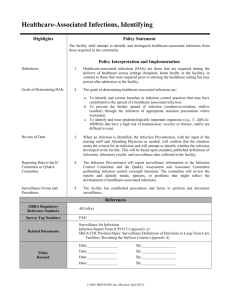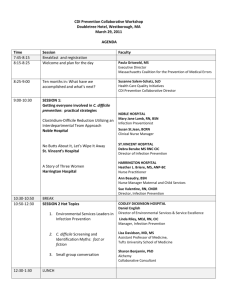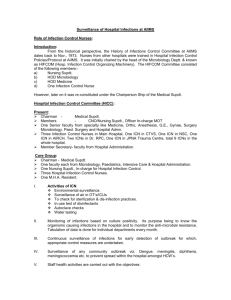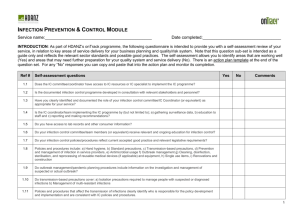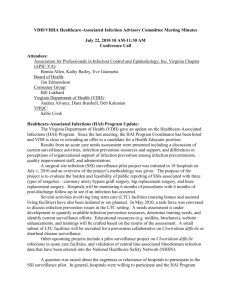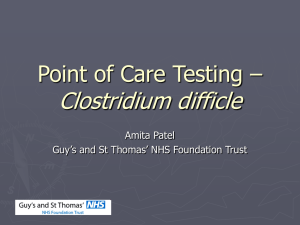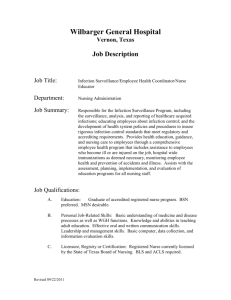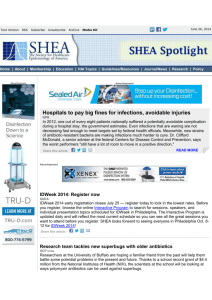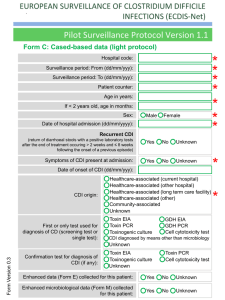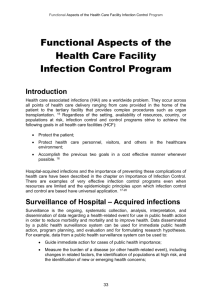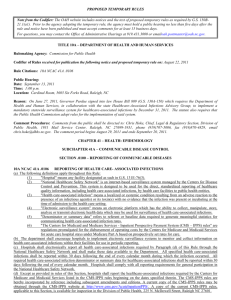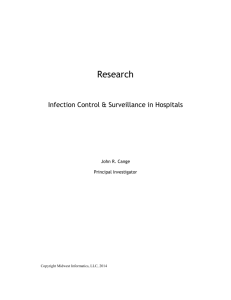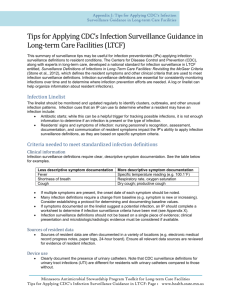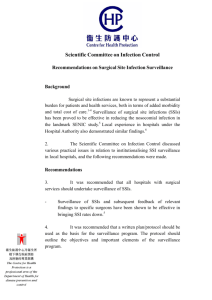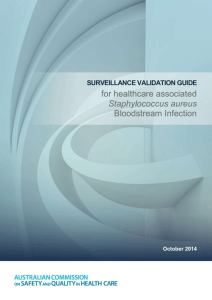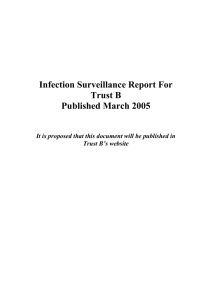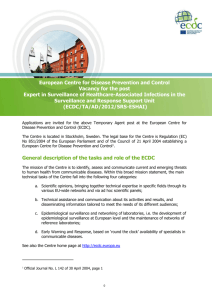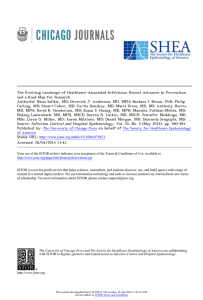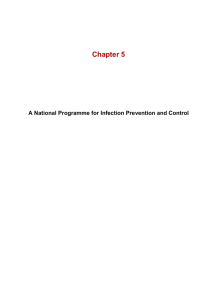Minutes for the Healthcare Acquired Infections Governance Group
advertisement
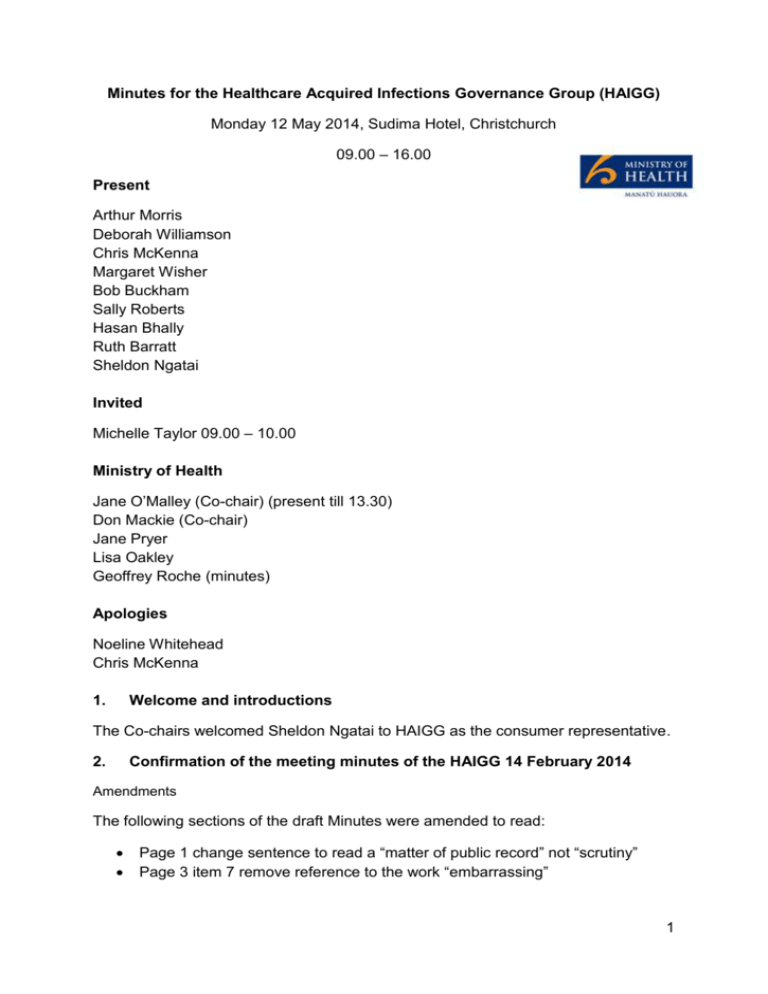
Minutes for the Healthcare Acquired Infections Governance Group (HAIGG) Monday 12 May 2014, Sudima Hotel, Christchurch 09.00 – 16.00 Present Arthur Morris Deborah Williamson Chris McKenna Margaret Wisher Bob Buckham Sally Roberts Hasan Bhally Ruth Barratt Sheldon Ngatai Invited Michelle Taylor 09.00 – 10.00 Ministry of Health Jane O’Malley (Co-chair) (present till 13.30) Don Mackie (Co-chair) Jane Pryer Lisa Oakley Geoffrey Roche (minutes) Apologies Noeline Whitehead Chris McKenna 1. Welcome and introductions The Co-chairs welcomed Sheldon Ngatai to HAIGG as the consumer representative. 2. Confirmation of the meeting minutes of the HAIGG 14 February 2014 Amendments The following sections of the draft Minutes were amended to read: Page 1 change sentence to read a “matter of public record” not “scrutiny” Page 3 item 7 remove reference to the work “embarrassing” 1 With the above amendments the minutes of the HAIGG 14 February 2014 were confirmed as a true and accurate record of that meeting. 3. IT and ICNet presentation A substantial discussion took place to discuss the need for a software package for the Infection Prevention and Control (IP&C) sector. This included: a paper outlining the use and utility of an IPC software suit for the purpose of surveillance and monitoring of healthcare associated infections a demonstration of ICNet software programme from Michelle Taylor from Canterbury DHB. Discussion Themes discussed included: benefits of an automated system differences between local and national surveillance systems procurement process for purchasing IPC software priority and the question of where IPC software fits with the Ministry’s plan for development of IT programmes. Action A suggestion that the Co-chairs to communicate to the Director General of Health the need for an IT system for the purpose of managing risk of HAIs, at both local and national levels. (This action supersedes earlier action of the writing of a letter to the IT board). 5. Action Plan update 13.1 Governance: Comment and Discussion on DHB IP& C capabilities The HAIGG would like to convey to District Health Boards an overview of how the governance group can support them Agreed: It was agreed that the Co- chairs (Jane O’Malley and Don Mackie) should attend the Chief Executives of DHBs meeting, in September rather than sending a letter. Action: The Co-chairs (Jane O’Malley and Don Mackie) to decide what the key IPC strategic messages will be. 2 Item 13.2: Surveillance: Letter to all DHB Labs. Completed action. Item 13.3: Surveillance: Consultation with HQSC, agreement to adopt SHEA definitions for hospital-based surveillance for CDI. Deborah Williams provided an update on progress on the establishment of the New Zealand Microbiology Network (NZMN). Deborah also informed HAIGG that the NZMN: will establish definitions for hospital based surveillance for CDI will then inform HAIGG on how best to establish hospital- based surveillance for CDI. Discussion: Themes of the discussion included: SHEA definitions for CDI whether CDI surveillance data would be used to compare the performance of DHBs. relationship between the NZMN and the HAIGG that the NZMN is a means of operationalising some of the HAIGGs activities, and a means of proposing the best way forward. Agreed: It was agreed that: i. ii. the SHEA definitions had been agreed previously for use in hospital definition for CDI surveillance data is not intended to act as a hospital performance indicator. Item 13.24 Workforce Capacity: Drafting of workforce development and post graduate education papers Discussion: Members discussed the draft paper on workforce development and the clarity of the content of the draft paper. Action: Workforce paper to be re-written and the reviewed again by HAIGG. 3 Item 13.25 Infection Prevention & Control Procedures: Development of best practice guidelines and standards for environmental cleaning of hospitals The Victorian Cleaning Standards have been put forward as way of standardising environmental cleaning practices in healthcare facilities as it offers a cleaning audit tool. Discussion: Could problems (cleaning) become more apparent as standards are implemented? Majority of hospitals are already using the Victorian Cleaning Standards (VCS). Action: Follow up to be sought following the Directors of Nursing meeting in March 2014, as use of the VCS was itemised (unfortunately representative for this item not present at today’s meeting) 6. Antimicrobial Stewardship Discussion: Several papers on Antimicrobial Stewardship had been circulated to the HAIGG. Given that New Zealand’s ability to be influential at a global level is limited, the discussion focused on local issues. Issues identified were: the need for better enforcement of prescribing practices, in particular in smaller hospitals inadequate clinical guidance inadequate consumer medical literacy inadequate communications amongst staff a lack of evidence based guidelines the lack of teams who can provide robust advice antibiotics shortages inadequate surveillance A scoping research paper draft was compiled by the Health Quality and Safety Commission, which provided advice in three parts: i. ii. iii. National coordination Guidelines Quality improvement measures. 4 Actions: The following actions were identified i. ii. iii. iv. 7/9. determine what is already being done in New Zealand to manage “bugs” and whether the ‘machinery’ required already exists. statement to be drafted on expectations of DHBs. This statement will be used in discussions with CMOs. review of the Australian Therapeutic Guidelines (for possible adaptation by NZ) invite representatives from PHARMAC and MPI to next HAIGG face to face meeting. Strategic Plan The HAIGG strategic Plan was circulated for comment; refer to the draft Strategic Plan for specific edits discussed. It was noted that the Accident Compensation Corporation (ACC) is looking into hospital acquired infection and associated injuries (secondary injuries after trauma, pressure injuries, wound infections and encephalopathy) and is interested in the HAIGG strategic plan. It was suggested that an ACC representative be invited to the next HAIGG meeting. 11. Items of interest / round the table Journal Articles Several journal articles were tabled as items of interest. Research Project Hasan Bhally presented a recent research project on HAIs conducted at Waitakere Hospital (a 135 bed secondary level care public facility with adult General Medicine and Rehabilitation wards) by Hasan, K. Read, S. Sapsford and T. Sapsford. The study aimed to determine the characteristics of patients with HAIs, and the proportion and spectrum of infections as an admitting diagnosis in patients. The researchers looked at all patients who had a diagnosis of infection on admission and if they had a hospital acquired infection. The diagnosis of infection was purely clinician based. The impact and severity of infections was not looked at. It was found that the most common types of infection were lower respiratory tract infection (LRTI) (41%). No difference in rate was seen associated with the type of device used, unlike other studies on the same issue. 5 Findings: Infection was found to be a common clinical admitting diagnosis in hospitalised patients, with a diagnosis of LRTI often not supported by microbiological tests. HAI is prevalent (10.7%), and urinary tract infection is the most common type in the setting studied. Patients with HAI are older, have longer stays, and are more likely to be present in a rehabilitation ward at the time of diagnosis. The findings emphasise the need to determine the setting of the infection and the importance of determining how many of these infections are actually preventable. Most hospital acquired pneumonias and most non- catheter related UTIs could not have been prevented. General Discussion: It was noted that a SHEA paper on obligatory vaccination for healthcare staff has shown that this is clearly beneficial. It was also noted that new Worksafe policy required that there is now an obligation on workers to ensure the safety of others in their organisation. It was noted that there is an analogue with workplace smoking policies. A recent British Medical Journal article on the pros and cons of obligatory vaccination had recently been published. Action: It was decided that obligatory vaccination be placed on the HAIGG action point list 12. Meeting Closure The meeting closed at 15.15 6
